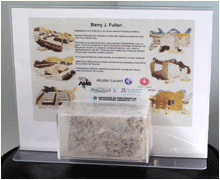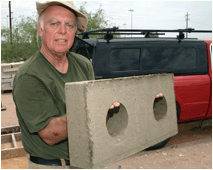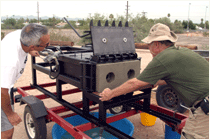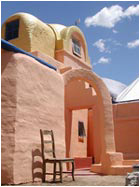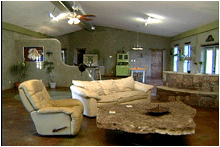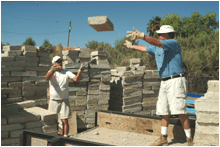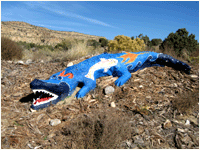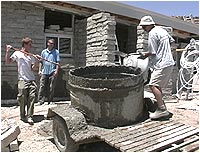. The French architecture firm designed the complex to be constructed from 100 repurposed
. Talk about putting your students in a box!
promoted by the Centre régional des œuvres universitaires et scolaires (CROUS) of Haute Normandie (an administrator of student assistance in France. The contest challenged architects to explore creative designs for student housing complexes that utilize shipping containers, with the aim of creating the first such structure in the country.
Olgga came in second place with their design, which comprises 2,900 square meters and would cost around 4.5 million euros. Each container is a room for one student, complete with a study area, bathroom, and living room. For more amazing shipping container abodes, check out
.

This beautiful sunset observatory made from
recycled shipping containers was recently constructed in the harbor of
Songdo New City in Incheon, South Korea. Designed and built by
AnL Studio, “OceanScope” is a composed of five
recycled containers, each one angled at a different height to provide 3 distinct views of the harbor.















Numerous
disaster relief housing projects have been proposed to help in the aftermath of the
Haiti Earthquake last month, and while many of them seem workable, none (as of yet) will actually be implemented. But a new
shipping container project designed by Richard Moreta and his team may change all that. Dominican Authorities just recently gave approval for Moreta’s “Container Cities” project, which utilizes a modular construction system along with
recycled shipping containers, to be built in the Dominican Republic to supply housing for victims of the earthquake.
Read the rest of
Dominican Authorities Approve Container Cities For Haiti Housing Relief
Designed by Italian firm,
Tam Architecture, the idea for the complex was conceived when the architects noticed the leftover containers lying around the construction site and wanted to reuse them. Using them to provide the international staff of the cardiac center with a place to stay seemed like the perfect opportunity. The
housing units are 20 sqm and consist of a bedroom, a bathroom and a small veranda on the court side. There is also a cafeteria which is made out of smaller 7 ft x 40 ft containers.
In addition to being fabricated out of shipping containers that were already at the site (no extra fuel costs or shipping emissions!), Tam took extra measures to make the complex
energy-efficient. The containers are insulated with a layer system: 5 cm insulating panels on the inside and a second insulated roof and a bamboo brise soleil panel system on the outside, meaning that the sun’s rays never make contact with the containers.
Solar panels supply hot water for the compound and an air conditioning system that utilizes photovoltaic panels and chilling machines has been tested for the complex.
InterModal Design Launches New Prefab Shipping Container Units
Although modular by design,
shipping container architecture have mostly been executed by individuals or firms on a case by case basis. Now,
InterModal Design, a subsidiary of
Hive Modular, is changing the game with their newly launched line of prefab shipping container living units that you can order and have shipped right to you. The dwelling comes complete with a kitchen, living area that transforms into a bedroom and (in some units) a bathroom. The interiors are fairly spartan, but the intention is for these units to be affordable and capable of shipping anywhere
.
InterModal Design was started after the co-founder of Hive Modular, Paul Stankey, built a
shipping container cabin in Northern Minnesota for his family. After the success of their project, they felt confident they could provide a similar service to others looking for affordable and strong living units made from shipping containers.
There are currently six different designs available already – from basic 20 foot containers with the bare necessities to double wide container houses with two rooms. The current line focuses on
auxiliary structures, but the design team is capable of drawing up more complicated structures with higher end finishings. As they say, “with shipping containers, the sky is the limit.” Check out their
website for more details about their designs and contact them for a sheet on pricing.
Shipping Container Cities to Shelter 2 Million Haitians From Hurricanes

There's been a lot of
disasters this year, but the aftermath of the
Haiti Earthquake has left the country in a dire state and with hurricane season approaching,
2 million people are without adequate shelter and living in tents. Relief in the form of shipping container housing is in progress, but
help is still needed. Richard Moreta and his team,
Green Container International Aid, who we covered back in February, have been working on securing a large number of used shipping containers for use in their
Container Cities. Moreta recently sent us an email
asking for support for the people of Haiti -- specifically he needs help amplifying his message to authorities, those in power or with business connections to donate shipping containers and help save lives.
Please read on and spread the word!

Moreta and his team,
Green Container International Aid, have been working non-stop to begin construction on their Container Cities. A pilot project has already begun in Jacmel, which lies along the Caribbean Sea, in the Southern part of Port-Au-Prince. They will start building emergency shelters as soon as they start receiving shipping containers, which can be quickly retrofitted into durable structures that can withstand the hurricane season. These basic structures will include new exterior paint, plywood floors, a Green Roof (geo-textile fabric, gravel layers, humus, vegetation), fabric covers over the top to protect them from the sun and collect rain water, a screen panel at the entry doors of the containers to provide for mosquito protection, and a foundation. After enough shelters have been provided for the victims, the homes can be further built-out and made more habitable.
Richard Moreta has recently been down to Haiti trying to secure shipping containers, determine the best ways to utilize them, and prioritize their efforts. The situation, as Moreta told us, is not good. Right now there are
2 million people living in tent camps, and when hurricane season starts in June, they will have no protection. Experts are predicting that a major hurricane landfall in Haiti is likely this coming season due to a weakening of El Niño, so hurricane-resistant shelters need to be constructed NOW in order to secure the safety of Haiti’s disaster-stricken population. On top of that, many Haitians are now terrified of concrete buildings, and many do not want to be inside for fear that another earthquake will demolish it with them inside. Seismologists also fear that those cracked buildings will not be able to withstand hurricane strength winds.
 This is a call for help.
This is a call for help. Moreta and his team are asking for a
MASSIVE DONATION of shipping containers from around the world to be shipped to Haiti. Hapag-Lloyd, the biggest container company in the world, has already donated 5 shipping containers to their efforts, but many more are needed. This is where we start the revolution and spread the word. If Betty White can get on Saturday Night Live through a Facebook group, then surely we can get other major companies (like Costco, Home Deport, Wal-Mart, Target, etc.) to donate containers and have them shipped to Haiti. There are only
2 MONTHS left before the start of the hurricane season. The Green Container International Aid team
has a solution in place, but they don’t have the containers. If you want to help the people of Haiti, spread the word,
visit the GCIA Facebook page and help them in their quest to acquire containers!
Gorgeous Shipping Container Art Studio in New York

Wow! We knew that
shipping containers could be used to build beautiful buildings, but this art studio by
MB Architecture in Amagansett, New York is truly gorgeous. The artist had a limited budget of $60,000 to work with and wanted something close to home that was both functional as a working space, but would also be inviting and reflective. The exterior is kept very simply as the shipping container, but painted gray for a sophisticated look and a way to blend the container into the wooded environment. Inside, bright white walls act as a blank canvas for new artwork and ample daylighting streams in through the large windows on either end.
The foundation for the studio is built into the earth with 9′ walls and acts as the lower level and work space for the studio. Two 40′ (9′6″) high cube
shipping containers were then set on top of the foundation to create a two-story double wide structure. About 75% of the floors of the containers were cut away to create the tall ceilings with lots of
natural light flooding in from the high windows.
Next to the painting area on the lower floor is a large storage area and directly above on the top floor is another work area. The container wide staircase acts as a transitional and gallery space for artwork. Each of the two containers cost about $2,500 delivered. An amazing example of how beautiful shipping container architecture can be.














































